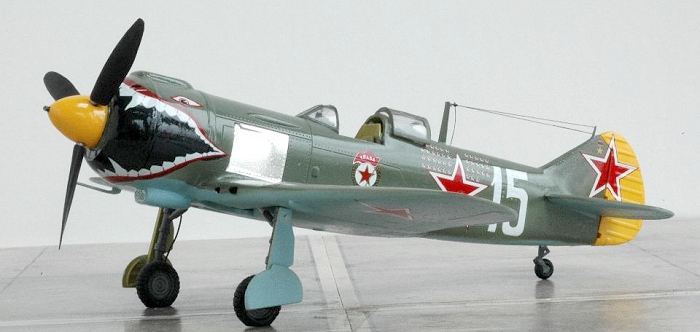
Hobbycraft 1/48 La-5/7
| KIT #: | 1589/1590 or 1530 |
| PRICE: | Around $12-15 |
| DECALS: | See review |
| REVIEWER: | Andrew Garcia |
| NOTES: | Various aftermarket bits used. See review |

| HISTORY |
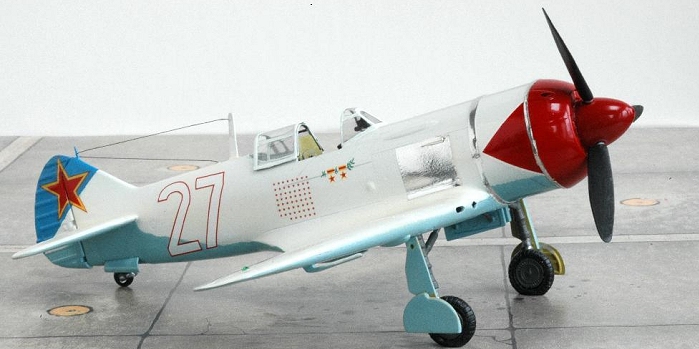
The Lavochkin La-5 and La-7 series of fighters were flying overhead in May
of 1945 as the Red Army was grinding towards Berlin with burning German
Panther tanks scattered about the country side. This colorful statement is
a summary of the cover of the Squadron reference La 5/7 Fighters In Action
# 1169. What is clear, according to many accounts, the La-5 was the first
Soviet fighter with performance superior to that of the German Bf-109G. The
La-5 series was the most widely used radial engined fighter in the Soviet
Air Force with 9,920 built during “The Great Patriotic War”. The
Czechoslovaks have the distinction of being the sole operators of the La-5
outside of the Soviet Union. The wooden, radial engined aircraft was the
mount of the top scoring Allied ace, Ivan Kozhedub. Kozhedub had the
distinction of flying at Kursk as his combat debut. Within days he was
credited downing four aircraft in one day (two Stukas and two Bf-109’s).
Many more victories followed and later he was credited with shooting down a
Me-262 while piloting the La-7 on Feb. 15, 1945, as the war drew to a
close.
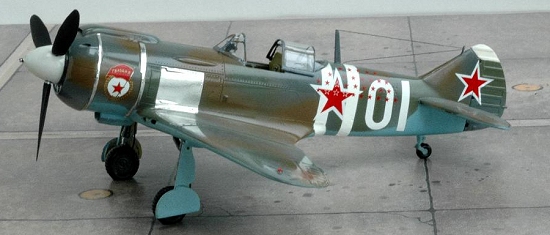 There are similar parallels in Japanese aviation with a good in-line engine
fighter becoming much better with the grafting of a larger, more powerful
radial engine (the La-5 used the M-82 engine) to the same airframe. Such
was the case with the La-5 and La-7 where a good design, the LaGG-3, was
made even better by the transformation to a radial power plant design.
Using a series of aviation techniques found on other aircraft such as the
close fitting, tapered cowl used on the Fw-190 with a similar engine
fan layout created another winning design. Because the La-5 prototype was
converted from the LaGG-3 the cockpit components were nearly the same
speeding up the development cycle.
There are similar parallels in Japanese aviation with a good in-line engine
fighter becoming much better with the grafting of a larger, more powerful
radial engine (the La-5 used the M-82 engine) to the same airframe. Such
was the case with the La-5 and La-7 where a good design, the LaGG-3, was
made even better by the transformation to a radial power plant design.
Using a series of aviation techniques found on other aircraft such as the
close fitting, tapered cowl used on the Fw-190 with a similar engine
fan layout created another winning design. Because the La-5 prototype was
converted from the LaGG-3 the cockpit components were nearly the same
speeding up the development cycle.
Although the radial engine was much heavier than the LaGG-3’s in-line
engine, the M-82 engine’s greater horsepower provided 5mph more speed at
sea level and at least 21 mph more at 20,000 feet. The combined increased
speed and greater climb rate, despite a weight gain, turned this
aircraft into the workhorse needed by the VVS. One month of trials and
it was in mass production with the first La-5 aircraft leaving the
production lines in April of 1942.
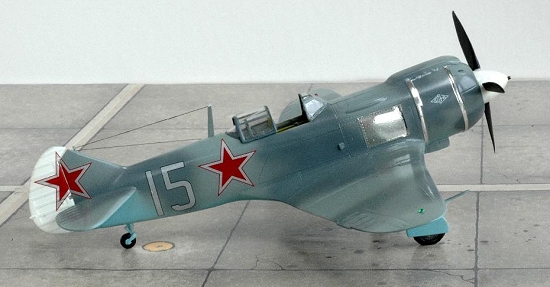 A few changes such as increasing the engine oil cooler size, which was
mounted below the engine and in front of the wing root along with an air
intake fairing and gun breech bulges created the distinctive La-5
appearance. The early production La-5 had a small door above the main strut
cover and had the antennae wires leading directly into the vertical fins
edge. Shortly after production started the antennae were relocated to a new
post at the top of the vertical fin.
A few changes such as increasing the engine oil cooler size, which was
mounted below the engine and in front of the wing root along with an air
intake fairing and gun breech bulges created the distinctive La-5
appearance. The early production La-5 had a small door above the main strut
cover and had the antennae wires leading directly into the vertical fins
edge. Shortly after production started the antennae were relocated to a new
post at the top of the vertical fin.
The German aircraft industry, however, was also moving forward and the
Bf-109G-2 that was soon encountered proved to be a better aircraft in
general. Just when things looked better for the Soviets along came the
Focke Wulf Fw-190. LaGG added fuel injection and boost (supercharging) to
push performance in an attempt to stay competitive in the air war.
Refinements were made to the La-5 airframe resulting in the La-7. The
prototype was completed in January of 1944. The La-5’s“starter dog” found
at the tip of the nose spinner for attachment to an external power source
to start the engine was deleted in the La-7. Numerous other design changes
resulted in a similar looking but very different aircraft. The LA-7
featured improved visibility with a cut-down rear quarter and a retracting
rear landing gear leg with clamshell doors.
| THE KIT |
When the Hobbycraft La-5 and La-7 kits were released in the 1980’s it
featured a mix of heavy and fine details. Fabric on the surface controls
was much too heavy. The scribing on the fuselage and wings was recessed and
fine enough to be acceptable. There are no canopy options; the canopy
that comes with the kit can only be posed in the closed position. Cockpit
detail is crude, and may be to the liking of scratch builders but I opted
for a resin replacement from True Details.
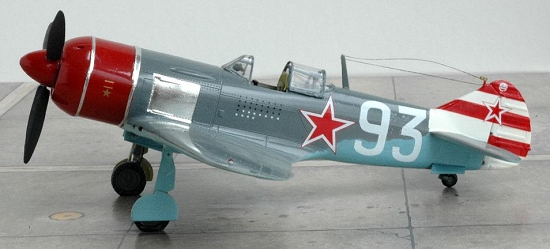 Once I built the first kit I realized with a lot of aftermarket additions
it looked acceptable. Without all the added aftermarket I would not enjoy
the kit since it is just too crude. There are also parts for the La-5FN, in
the La-7 box but this later kit is really a La-7 with La-5 parts. Some have
said, “ Don’t go near it” but I prefer to build them all if there is no
other kit available. It took about ten years before Gavia came out with
their release of the La-7. As for the La-7, it looks like one until you
build a Gavia kit, which is without a doubt a much better representation.
My goal when I built these kits was to enjoy the color schemes and decals.
This build provided me with that satisfaction.
Once I built the first kit I realized with a lot of aftermarket additions
it looked acceptable. Without all the added aftermarket I would not enjoy
the kit since it is just too crude. There are also parts for the La-5FN, in
the La-7 box but this later kit is really a La-7 with La-5 parts. Some have
said, “ Don’t go near it” but I prefer to build them all if there is no
other kit available. It took about ten years before Gavia came out with
their release of the La-7. As for the La-7, it looks like one until you
build a Gavia kit, which is without a doubt a much better representation.
My goal when I built these kits was to enjoy the color schemes and decals.
This build provided me with that satisfaction.
My kit building started with the traditional modeler’s delight over getting
some nice decals from Superscale and Aeromaster and wondering what the
black and white decal placement drawings would look like when the paint and
decals were applied. I knew very little about this aircraft when I started
and built the kits solely due to the interesting color schemes that the
aftermarket decal makers provided. At the time I built these kits there
were very few reference books on Soviet W.W.II aircraft. The few I found
helped a great deal. Unfortunately the excellent Squadron In Action book
was not available so a few errors that I could now avoid went into the
build. The In Action book is exceptional with all the details and drawings
needed
to understand the La-5/7 nuances.
I built one aircraft to get a feel for the subject. This confirmed they all
needed every piece of resin and etched metal I could add since they were
still somewhat crude despite my efforts to upgrade the plastic. Despite all
the aftermarket additions I did not lapse into AMS – they were fast builds,
which I prefer. After building the batch of five aircraft I bought a few
more Hobbycraft kits for a second project because there were some decal
options I had not used. To date I have not gotten around to building them –
since I was seduced by a few new releases from Monogram, Hasegawa and
Tamiya along the way. Then along comes Gavia with a nice rendition…… So,
the purpose of this article is to encourage you to build the Hobbycraft
La-5/7’s in your stash because it is a fun build if you don’t mind a few
inaccuracies.
| CONSTRUCTION |
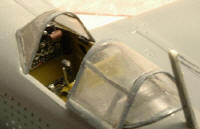 Construction started with the cockpit. I opted from day one to use the
inexpensive and very nice Squadron True Details resin cockpit, #48463 LA-5
cockpit detail set. To this I added the insight details (now sold by Meteor
under the CE label) stock # 25007 U.S.S.R. PBP-1B gunsight, and True
Details 48097 La-5 resin wheel set. I wanted to create as good a model as
possible so I also added the Eduard 48-013 etched metal set to the
construction. After the first kit was finished the canopy looked poor (it
is far too thick). I added the Squadron vac canopies t
Construction started with the cockpit. I opted from day one to use the
inexpensive and very nice Squadron True Details resin cockpit, #48463 LA-5
cockpit detail set. To this I added the insight details (now sold by Meteor
under the CE label) stock # 25007 U.S.S.R. PBP-1B gunsight, and True
Details 48097 La-5 resin wheel set. I wanted to create as good a model as
possible so I also added the Eduard 48-013 etched metal set to the
construction. After the first kit was finished the canopy looked poor (it
is far too thick). I added the Squadron vac canopies t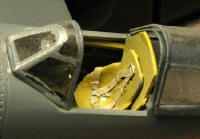 o the mix to get much
better results. With a good paint job, it looks fairly decent. I painted
everything using Aeromaster Medium Gray and Model Master Light Ghost Gray.
Once the resin is assembled, it’s simply a matter of dropping the resin
cockpit into the fuselage. I assembled the wings and added the vertical
tail using two pieces of paper clip wire as locator pins to attach it.
o the mix to get much
better results. With a good paint job, it looks fairly decent. I painted
everything using Aeromaster Medium Gray and Model Master Light Ghost Gray.
Once the resin is assembled, it’s simply a matter of dropping the resin
cockpit into the fuselage. I assembled the wings and added the vertical
tail using two pieces of paper clip wire as locator pins to attach it.
I then attached the wings to the fuselage and continued by filling in the
gaps and seams with putty. A fast sanding with flex-I-files and it was
ready for paint.
The fit was fine overall. I also built up the spinner and drilled a hole
for some plastic rod for the La-5 versions. Once the rod was set I
used a triangular file to cut a notch in the end to simulate the La-5’s
“starter dog” which is an example of the finer details left off the Academy
kit. The oil cooler went on but lacked location pins. I put it in an
approximate place after I added the Eduard etched screen and painted the
inside black.
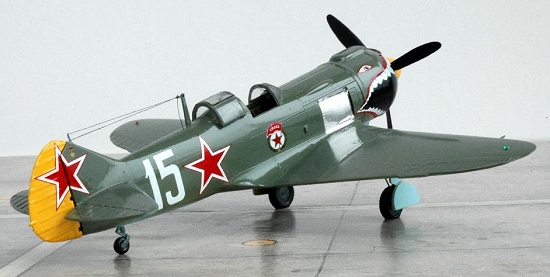 The Squadron vac canopy was masked and painted separately. It was attached
as a final step along with the antennae wires and wing lights. I used the
MV Products (#LS220+LS221) green and red light lenses used in model
railroads to try and improve the overall look. I was not skilled with
weathering at the time I built these kits so they look too pristine for my
taste today. Even looking at them today they seem to lack much in the way
of panel lines and fine details to benefit from washes, as do many other
kits with finer details. A heavy wash and some chalk pastels along with
some Tamiya smoke on the metal exhaust heat shields would be a next step if
I were to go back and update these kits. I often think I will go back and
do some final touches but I never have.
The Squadron vac canopy was masked and painted separately. It was attached
as a final step along with the antennae wires and wing lights. I used the
MV Products (#LS220+LS221) green and red light lenses used in model
railroads to try and improve the overall look. I was not skilled with
weathering at the time I built these kits so they look too pristine for my
taste today. Even looking at them today they seem to lack much in the way
of panel lines and fine details to benefit from washes, as do many other
kits with finer details. A heavy wash and some chalk pastels along with
some Tamiya smoke on the metal exhaust heat shields would be a next step if
I were to go back and update these kits. I often think I will go back and
do some final touches but I never have.
| COLORS & MARKINGS |
Painting
I used Aeromaster and Model Master enamel paints overall with some Gunze
Sangyo for small details. The prominent heat shields were treated to Bare
Metal foil. This was a simple step and added a lot to the aircraft. I also
used Bare Metal foil for the cowling strips.
| FINAL CONSTRUCTION |
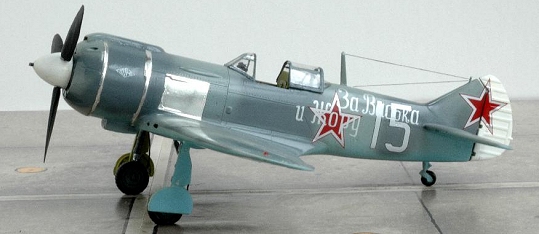 I painted the wheel wells and all the landing gear parts Model Master RLM
02 since it is close to the color used on the planes by the Russians. I
attached the gear legs on the plane and added some wire for the hydraulic
brake lines. When I installed the main gear doors they looked very clumsy.
After looking at them a bit I felt the resin wheels offset this
deficiency. I decided to get the project done so I wrapped up the project
with small touch up painting steps. On the La-7 aircraft I replaced the
plastic pitot tips with some guitar wire. That was my final step. I
certainly enjoyed the decaling and end results for the five red stars.
I painted the wheel wells and all the landing gear parts Model Master RLM
02 since it is close to the color used on the planes by the Russians. I
attached the gear legs on the plane and added some wire for the hydraulic
brake lines. When I installed the main gear doors they looked very clumsy.
After looking at them a bit I felt the resin wheels offset this
deficiency. I decided to get the project done so I wrapped up the project
with small touch up painting steps. On the La-7 aircraft I replaced the
plastic pitot tips with some guitar wire. That was my final step. I
certainly enjoyed the decaling and end results for the five red stars.
Decals
Once the Testors Gloss Coat had dried, I proceeded to decal the planes. The
decals were from Superscale and Aeromaster. The Aeromaster decal is an
early release using the black & white profiles rather than the color
instructions we have come to enjoy. At this point I’ll list the five
aircraft I built in a batch with the specific components and modifications
used:
La-5 Early “White 15” Pilot – Captain Gregori Kostylev 3rd GV. IAP
Hobbycraft HC1589
Decal – Aeromaster 48-009 (an early one!)
True Details La-5 Resin Cockpit Detail (#48463)
Eduard Etched Metal #48013
True Details La-5 Resin Wheel #48097
MV Products Red & Green Wing lights (LS220 & LS221)
References: Red Stars by Guest, Keskinen & Stenman page 34 full-page photo
Squadron La 5/7 In Action # 1169 rear cover color drawing
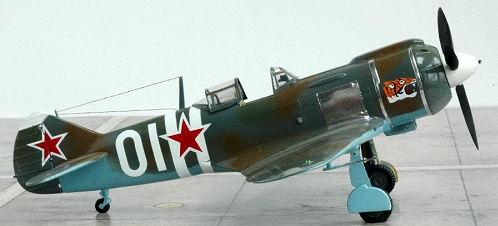 I used the kit canopy and it looks terrible. It is too thick and does not
fit in an open pose. However, it was partially intentional since I had to
modify the rear quarter to convert the kit to an early La-5 and a vacuform
canopy could not handle the modifications. I left the sliding canopy
segment on in the pictures to illustrate how poorly it looks and fits
after you separate the canopy. The early La-5 rear quarter required some
epoxy putty to re-contour the supercharger bulge on the cowling top and the
air intake at the top edge of the cowling. The large nose decal was part
decal and partly painted. I used a paper paint mask from the Aeromaster
decal instructions to mask the black portion and some red paint , hand
painted, to complete the mouth.
I used the kit canopy and it looks terrible. It is too thick and does not
fit in an open pose. However, it was partially intentional since I had to
modify the rear quarter to convert the kit to an early La-5 and a vacuform
canopy could not handle the modifications. I left the sliding canopy
segment on in the pictures to illustrate how poorly it looks and fits
after you separate the canopy. The early La-5 rear quarter required some
epoxy putty to re-contour the supercharger bulge on the cowling top and the
air intake at the top edge of the cowling. The large nose decal was part
decal and partly painted. I used a paper paint mask from the Aeromaster
decal instructions to mask the black portion and some red paint , hand
painted, to complete the mouth.
La-5FN “White 01” (some profiles show it as Yellow 01) Pilot Vitali I.
Popkov
Hobbycraft HC1589
Decal – Aeromaster 48-086
True Details La-5 Resin Cockpit Detail (#48463)
Eduard Etched Metal #48013
True Details La-5 Resin Wheel #48097
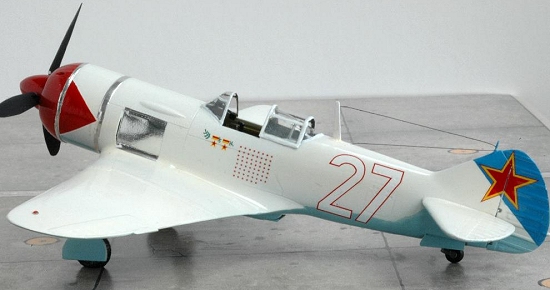 MV Products Red & Green Wing lights (LS220 & LS221)
MV Products Red & Green Wing lights (LS220 & LS221)
Insight Details resin gunsight USSR PBP-1B #25007
Squadron Products vac form canopy (#9524)
References: Fighting Lavochkins page 32 - 33 color three-view drawing
Stalins Eagles, Hans D. Seidl Schiffer Books 1998 page 355 color
profile
Squadron La 5/7 In Action # 1169
La-5FN “Silver 15” “For Vasek and Zhora” Pilot Capt. P. Likholetov
159th IAP, 275th Fighter Aviation Division, 13th Air Army Leningrad 1944
Hobbycraft HC1589
Decal – Aeromaster 48-009
True Details La-5 Resin Cockpit Detail (#48463)
Eduard Etched Metal #48013
True Details La-5 Resin Wheel #48097
MV Products Red & Green Wing lights (LS220 & LS221)
Insight Details resin gunsight USSR PBP-1B #25007
Squadron Products vac form canopy (#9524)
References: Squadron La 5/7 In Action # 1169 photo page 20, color
profile
page 25
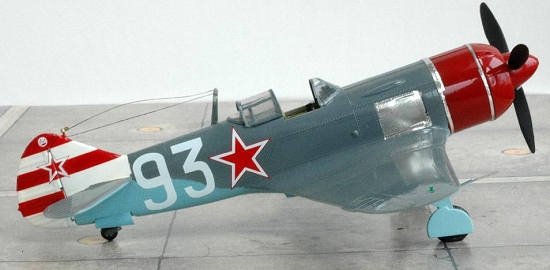 La-7 “White 93” Lt. Col. Dolgushin
La-7 “White 93” Lt. Col. Dolgushin
165th IAP 4th Air Army Germany 1945
Hobbycraft HC1589
Decal – Aeromaster 48-009
True Details La-5 Resin Cockpit Detail (#48463)
Eduard Etched Metal #48013
True Details La-5 Resin Wheel #48097
MV Products Red & Green Wing lights (LS220 & LS221)
Insight Details resin gunsight USSR PBP-1B #25007
Squadron Products vac form canopy (#9524)
References: Stalins Eagles, Hans D. Seidl Schiffer Books 1998 color
profile
page 354
Squadron La 5/7 In Action # 1169
La-7 “White 27” In Winter Camouflage Pilot: Ivan Kozhedub
176th GV IAP Winter Germany 1945
Hobbycraft HC1530
Decal – Superscale 48- 428
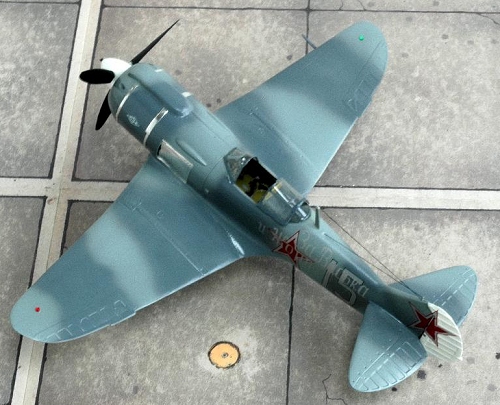 True Details La-5 Resin Cockpit Detail (#48463)
True Details La-5 Resin Cockpit Detail (#48463)
Eduard Etched Metal #48013
True Details La-5 Resin Wheel #48097
MV Products Red & Green Wing lights (LS220 & LS221)
Insight Details resin gunsight USSR PBP-1B #25007
Squadron Products vac form canopy (#9524)
References: Squadron La 5/7 In Action # 1169
| CONCLUSIONS |
I really enjoyed these kits thanks to the exceptionally attractive markings from Aeromaster and Superscale. The prices for the kit and accessories were very reasonable and made for a limited challenge as long as plastic perfection is not your goal. With a little work, and lots of resin and etched metal it can be made in something that will almost rival the Gavia kit. I wholeheartedly recommend this kit to anyone looking for a fun build and anxious to put those great decals to use. This aircraft would have been a perfect match for an Eduard “zoom” set since the Eduard #48-013 etched metal was an early release and had too many parts that I was unable to use given the resin components were so good.
April 2005
| REFERENCES |
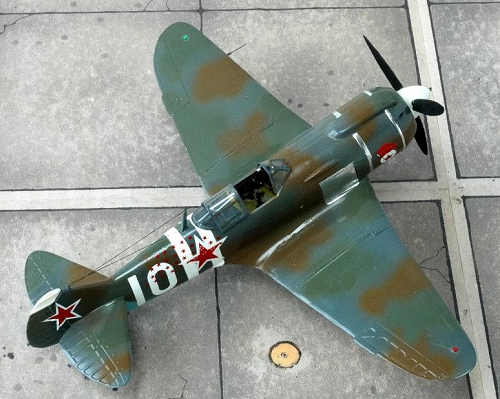 Fighting Lavochkin – Eagles of the East No. 1 by Michael Alanshin 1993
Fighting Lavochkin – Eagles of the East No. 1 by Michael Alanshin 1993
Red Stars – Soviet Air Force In World War Two 1939 – 1945, Geust, Keskinen,
Stenman , Ar-Kustannus Oy Finland 1993.
Squadron # 1169 La 5/7 Fighters In Action 1998.
Soviet Combat Aircraft of the Second World War Volume One: Single-Engined
Fighters, Yefim Gordon and Dimitri Khazanov 1998
Soviet Aces of World War II, Osprey Aircraft of the Aces # 15, Hugh
Morgan, Osprey Aerospace, London, 1998
Stalins Eagles, Hans D. Seidl Schiffer Books 1998
April 2005
If you would like your product reviewed fairly and quickly, please contact me or see other details in the Note to Contributors.